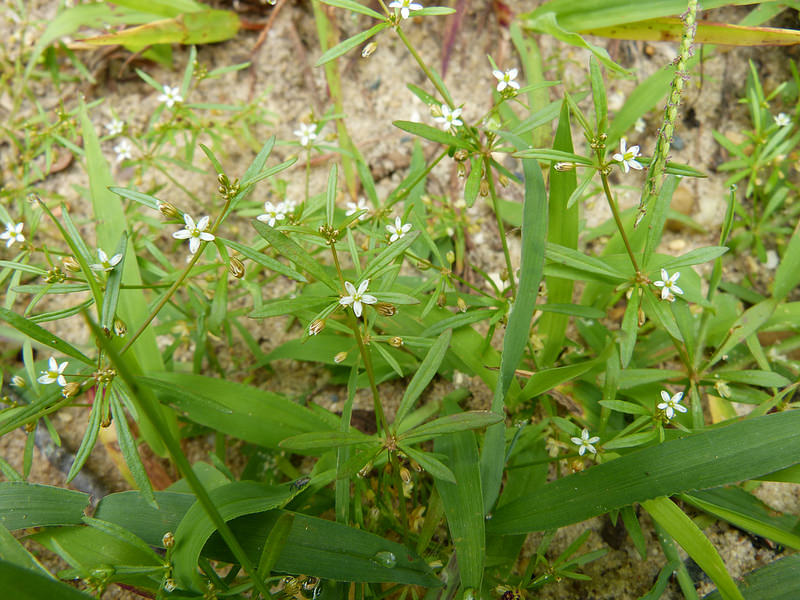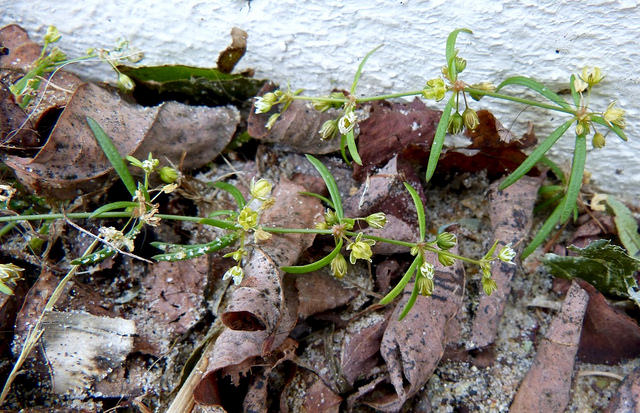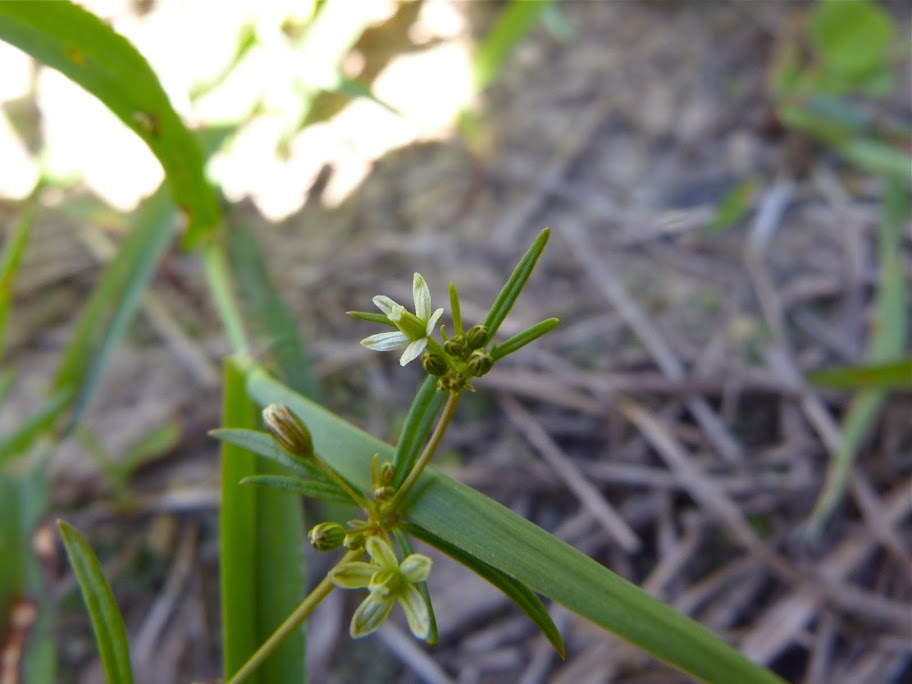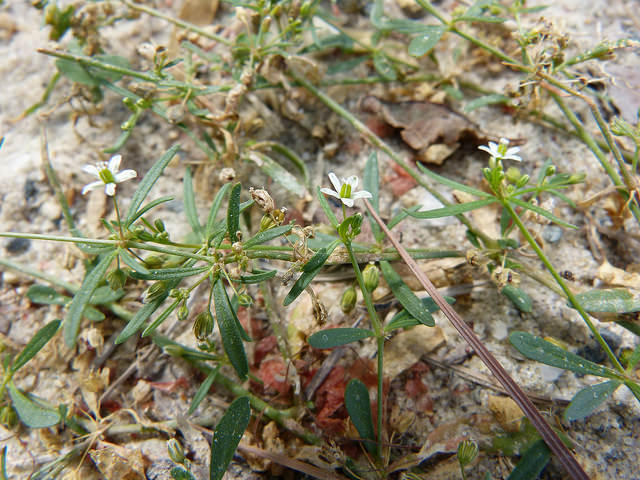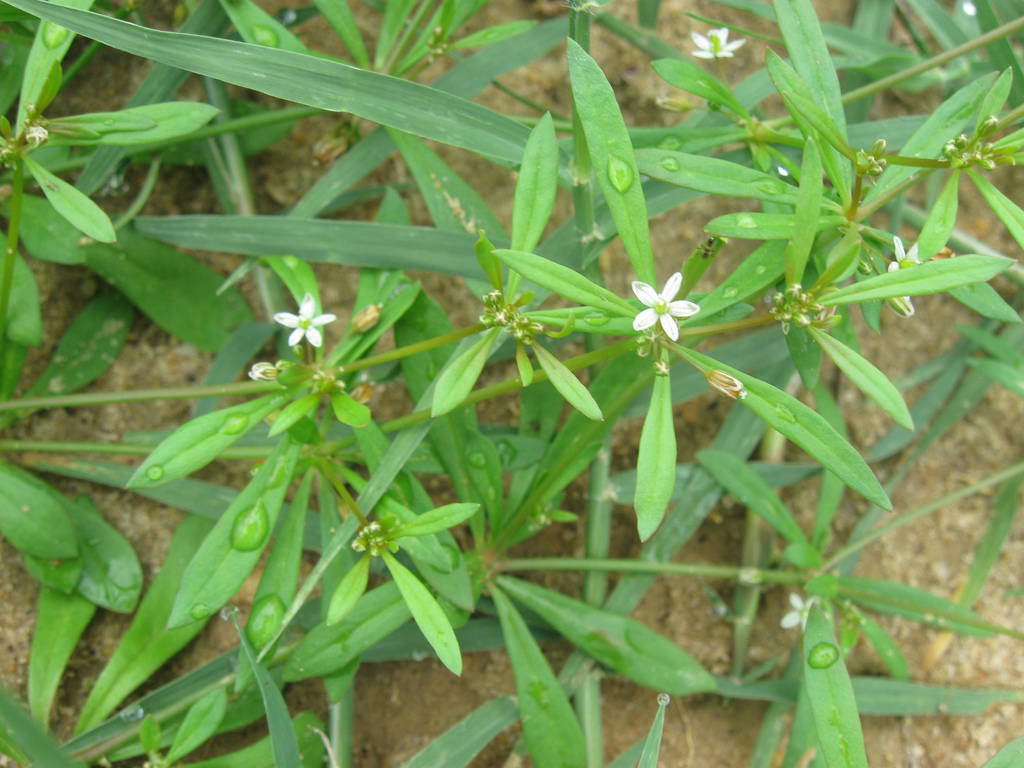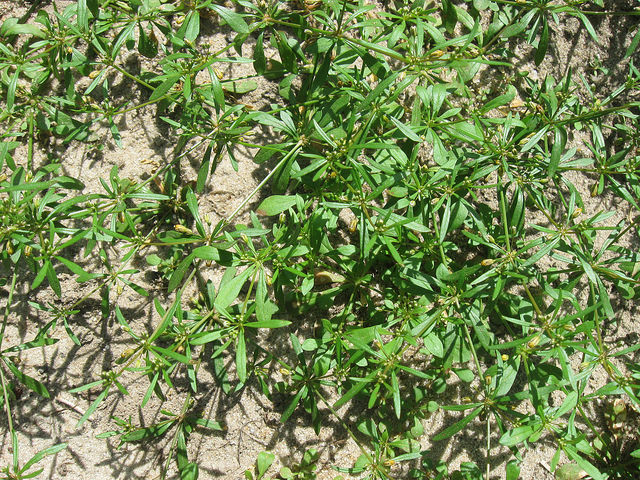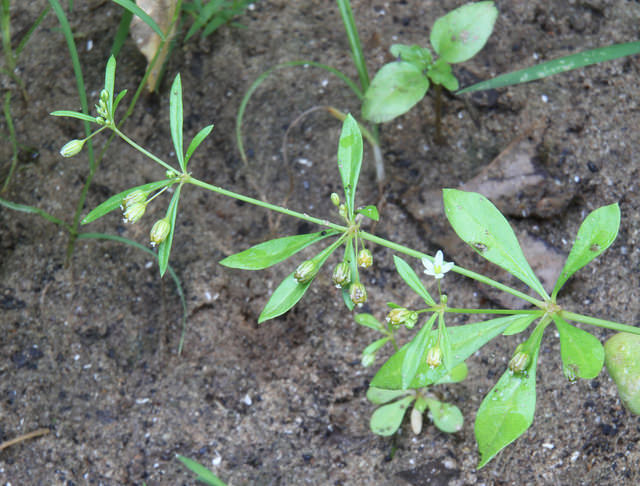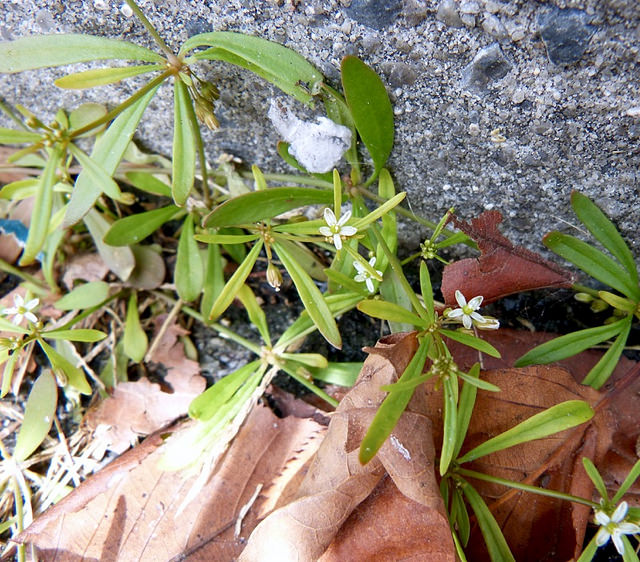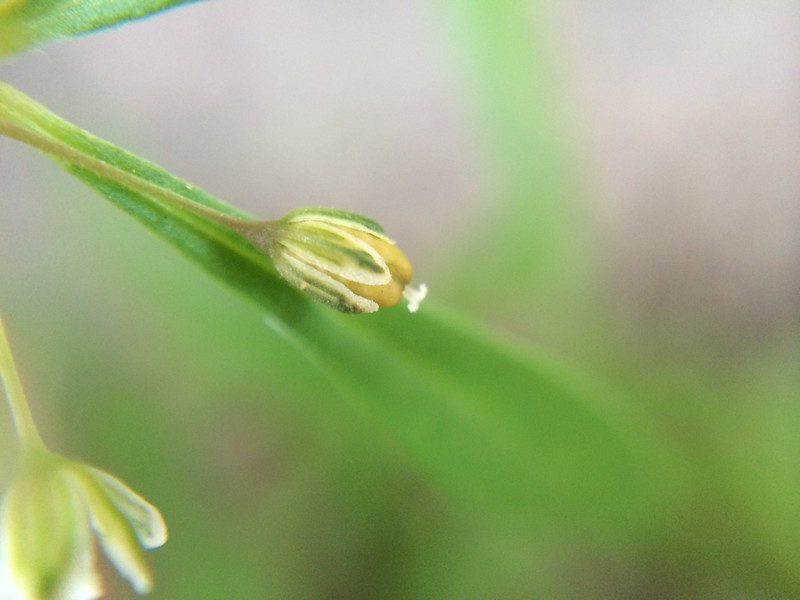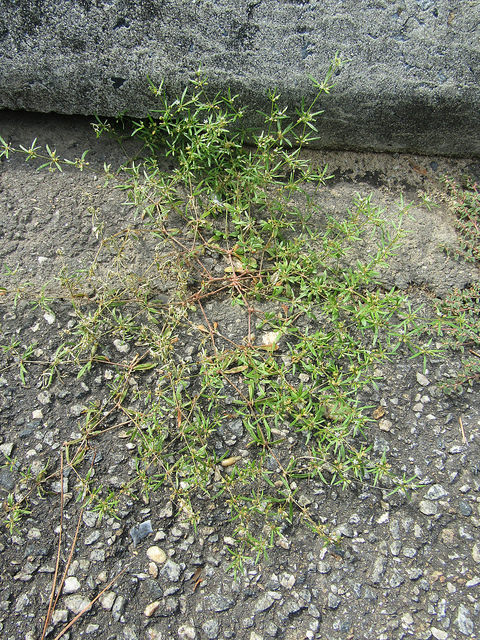Map Snapshot
























214 Records
Status
Apparently a species of the more tropical areas of the Americas that has expanded throughout the U.S.
Description
Reminiscent of a bedstraw. Small whitish flowers are composed of five petal-like sepals. Three to four stamens surround a greenish ovary. Leaves in whorls of 3 to 8. Seems to prefer sandy soils.
Seasonality Snapshot
Source: Wikipedia
| Mollugo verticillata | |
|---|---|

| |
| Scientific classification | |
| Kingdom: | Plantae |
| Clade: | Tracheophytes |
| Clade: | Angiosperms |
| Clade: | Eudicots |
| Order: | Caryophyllales |
| Family: | Molluginaceae |
| Genus: | Mollugo |
| Species: | M. verticillata
|
| Binomial name | |
| Mollugo verticillata | |
| Synonyms[2][3] | |
| |

Mollugo verticillata,[4] the green carpetweed[5] (also known as Indian chickweed[6]), is a rapidly spreading annual plant from tropical America. In eastern North America, it is a common weed growing in disturbed areas. It forms a prostrate circular mat that can quickly climb over nearby plants and obstacles. The species has been reported from every state in the United States except Alaska, Hawaii, and Utah, as well as from British Columbia, Manitoba. Ontario, Quebec, New Brunswick and Nova Scotia.[7] Although considered an invasive weed, M. verticillata is also known to be edible. Archaeological evidence has shown that M. verticillata has been in North America for about 3000 years. Sometimes also referred to as "Indian chickweed", in China this plant is referred to as zhong leng su mi cao.
Description
[edit]Carpetweed has narrow, whorled leaves, 3-8 at each node. At maturity the plant may lose its characteristic basal rosette formation. Leaves are approximately 1–3 cm in length and possess an obovate shape. Leaf apex may vary from rounded to acute.[8] The plant will grow and sprawl across the soil due to its habit of prostrate growth and form mats.[9] The flowers are usually in clusters of 2-5, blooming from July through September. Flowers are white or greenish white with tiny 5–15 mm stalks. Flowers quickly turn into fruit that is egg shaped and 1.5–4 mm in length. The dehiscent capsule opens at maturity. The seeds are 0.5 mm long and are red to rusty brown in coloration.[10][11][12]
Taxonomy
[edit]Advances in molecular genetic sequencing has improved understandings of the taxonomic relationship in the family Molluginaceae which had previously not been as inclusive.[13] Genera from Molluginaceae had previously been placed under Aizoaceae, Nyctaginaceae, and Phytolaccaceae before recent studies.[14] The genus Mollugo L. currently comprises about 35 species of annual herbs.[15] Several sub taxa species of M. verticillata have been reported due to its varying morphological nature however they are not thoroughly documented.[8] Mollugo verticillata has many accepted synonyms including: Mollugo dichotoma, Mollugo diffusa, Mollugo costata, Pharnaceum arenarium, and Pharnaceum verticellatum to name a few.[16] It is also referred to as alfombra in Spanish, and mollugine in French.[17] Other closely related sister taxa include Mollugo floriana, Mollugo flavescens, Mollugo snodgrassii, Mollugo crockeri, and Mollugo enneandra. [18]
Distribution and habitat
[edit]The wide range of M. verticillata is apparent across North America, Brazil, Colombia, Mexico, West Indies, Central America, South America, Eurasia and Africa.[19] There is agreement among some studies that the carpetweed origin is from the New World tropics and it spread into more temperate zones afterwards.[8] Overall the place of origin has been attributed to the tropics or subtropics of the northern and southern hemispheres.[20] Commonly found in warm and/or wet environments across North America.[9]

Uses
[edit]Along with Glinus (Molluginaceae), Mollugo are edible plants that have historically been utilized as vegetables or for medicinal benefits.[14] The family Molluginaceae has been studied for its therapeutic characteristics due to the production of triterpenes saponins and flavonoids[citation needed]. One study suggested that ethanolic extracts of M. verticillata could be a potential immunomodulator. The chemical makeup in members of the family Molluginaceae in general has anti-fungal and anti-inflammatory properties.[9]
Ethnobotany
[edit]Carbon dating has dated seeds of M. verticillata found in Icehouse Bottom Tennessee back to 1170- 140 B.C. Other seeds found in Troyville, Louisiana were dated back to 500 A.D. It is unsure exactly when or how M. verticillata spread into temperate North America. European movements were not the cause of this migration because carbon dating reveals that the plant was in the Little Tennessee river valley 3000 years ago. Despite little apparent food value, indigenous peoples may have had uses of M. verticillata that are unclear today. Carpetweed, also referred to as "Indian chickweed", was utilized as a potherb by the indigenous peoples of Southern Appalachia.[20][21]
Conservation status
[edit]Carpetweed is considered to be globally secure.[4] It is also credited as an invasive weed by USDA.gov.[22] IUCN RedList states that the taxon has not been assessed for the IUCN Red List.[23] Other accounts cite the weed as being native to the Continental US, Caribbean territories, Mexico and introduced to Canada.[17] It can be found in disturbed habitats such as fields, parking lots and gardens.[19]
References
[edit]- ^ "Selaginella apoda". NatureServe Explorer. NatureServe. Retrieved 2008-01-28.
- ^ The Plant List
- ^ Tropicos
- ^ a b "Taxonomy - GRIN-Global Web v 1.9.8.2". npgsweb.ars-grin.gov. Retrieved 2016-11-03.
- ^ NRCS. "Mollugo verticillata". PLANTS Database. United States Department of Agriculture (USDA). Retrieved 13 July 2015.
- ^ Bergen, Fanny D. (1892). "Popular American Plant-Names". The Journal of American Folklore. 5 (17). American Folklore Society: 89–106. doi:10.2307/533542. JSTOR 533542.
- ^ Flora of North America v 4 p 510
- ^ a b c "Mollugo verticillata in Flora of North America @ efloras.org". www.efloras.org. Retrieved 2016-12-03.
- ^ a b c Ferreira, A. P.; Soares, G. L. G.; Salgado, C. A.; Gonçalves, L. S.; Teixeira, F. M.; Teixeira, H. C.; Kaplan, M. A. C. (2003-01-01). "Immunomodulatory activity of Mollugo verticillata L.". Phytomedicine. 10 (2): 154–158. doi:10.1078/094471103321659861. PMID 12725569.
- ^ D'Arcy, W.G. 1987. Flora of Panama. Checklist and Index. Part 1: The introduction and checklist. Monographs in systematic botany from the Missouri Botanical Garden 17: v–xxx, 1–328.
- ^ P. D. Strausbaugh and Earl L. Core. Flora of West Virginia. 2nd ed. Seneca Books Inc., 1964. ISBN 0-89092-010-9
- ^ Richard H. Uva, Joseph C. Neal, and Joseph M. Ditomaso. Weeds of the Northeast. Cornell University Press, 1997. ISBN 0-8014-8334-4
- ^ Schäferhoff, Bastian; Müller, Kai; Borsch, Thomas (2009). "Caryophyllales phylogenetics: disentangling Phytolaccaceae and Molluginaceae and description of Microteaceae as a new isolated family". Willdenowia. 39 (2): 209–228. doi:10.3372/wi.39.39201.
- ^ a b "Molluginaceae in Flora of North America @ efloras.org". www.efloras.org. Retrieved 2016-11-03.
- ^ "UNC Herbarium". herbarium.unc.edu. Retrieved 2016-10-30.
- ^ "Mollugo verticillata L. — The Plant List". www.theplantlist.org. Retrieved 2016-10-30.
- ^ a b "ITIS Report Mollugo verticillata L." ITIS Standard Report. November 3, 2016. Retrieved November 3, 2016.
- ^ Christin, Pascal-Antoine; Sage, Tammy L.; Edwards, Erika J.; Ogburn, R. Matthew; Khoshravesh, Roxana; Sage, Rowan F. (2011-03-01). "Complex Evolutionary Transitions and the Significance of C3–C4 Intermediate Forms of Photosynthesis in Molluginaceae". Evolution. 65 (3): 643–660. doi:10.1111/j.1558-5646.2010.01168.x. ISSN 1558-5646. PMID 20955197. S2CID 41962430.
- ^ a b IPNI Plant Name Details. Vol. 1. Retrieved 2016-10-30.
{{cite book}}:|website=ignored (help) - ^ a b Chapman, Jefferson; Stewart, Robert; Yarnell, Richard (1973). "Archaeological Evidence for Precolumbian Introduction of Portulaca oleracea and Mollugo verticillata into Eastern North America". Economic Botany. 28 (4): 411–412. doi:10.1007/bf02862857. S2CID 39745222.
- ^ Core, Earl (23 December 1966). "Ethnobotany of the Southern Appalachian Aborigines". Economic Botany. 21 (3): 199–214. doi:10.1007/BF02860370. S2CID 29029467.
- ^ "Plants Profile for Mollugo verticillata (green carpetweed)". plants.usda.gov. Retrieved 2016-10-30.
- ^ "Search Results". www.iucnredlist.org. Retrieved 2016-12-03.
External links
[edit] Media related to Mollugo verticillata at Wikimedia Commons
Media related to Mollugo verticillata at Wikimedia Commons
